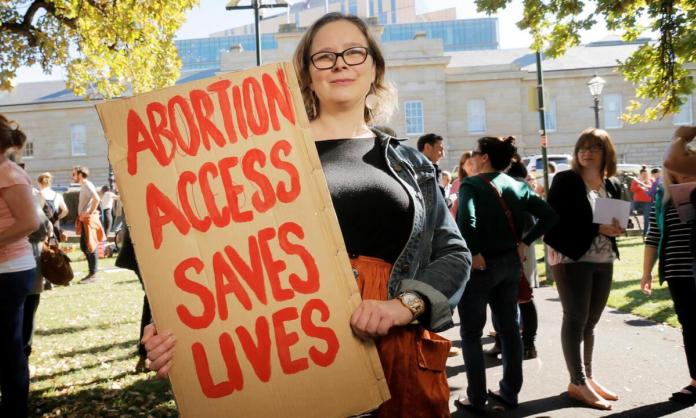The chants rang out through cities and towns around the world as protesters defiantly challenged the US Supreme Court’s 1 July decision to end national access to abortion: “We won’t go back!” and “Our bodies! Our lives! Our right to decide!”
The decision has encouraged bigots everywhere, including in Australia. But pro-choice activists have put the reactionaries on notice that their victory will be short-lived. And the activists are looking back in history to see how we’ve won before.
In Australia, abortion laws, based on nineteenth century English precedents, were ambiguous. They allowed some leeway for doctors to terminate pregnancies, but the operations were expensive, and inconsistencies in the law opened the door to corruption.
For those who couldn’t get through the legal hoops, but could scrape up the money, there were doctors available. But for those with little cash, backyard operators or other desperate remedies were the only option. Hospitals were filled with women suffering the after-effects, sometimes fatal, of botched operations.
By the late 1960s, restrictions on abortion were being challenged as rising militancy among workers brought the social and economic structures of capitalism to account. Pressure was mounting to end the protection rackets surrounding illegal abortion, and to increase the availability of the procedure. Importantly, the contraceptive pill, expensive as it was in Australia (it had a “luxury” tax put on it), gave women sexual freedoms they hadn’t had before. An economic boom increased the demand for female labour, which in turn fostered confidence among women to demand greater independence and control over their lives, and women workers to fight for those and other working rights.
Initially, the push to change abortion laws came from civil liberties groups and doctors, some looking to the law reform introduced in Britain in 1967. Although some abortions were legal, many doctors and patients nevertheless felt vulnerable, a situation made worse when Victorian police began a blitz on abortion-providing doctors in 1965.
Tackling law reform became more urgent, leading the Victorian Council for Civil Liberties (VCCL) to start a serious investigation into abortion in 1966, followed by the creation of a new organisation, the Abortion Law Reform Association (ALRA) in 1968. Through clarifying the law and increasing public knowledge about reproductive rights, the VCCL hoped to improve women’s access and safety. More actively, the council backed the editor and distributor of the Melbourne University student publication Farrago when they were charged in 1967 with obscenity for publishing articles on contraception and abortion. Farrago won the case.
To champion the rights of women most effectively, the VCCL and ALRA also needed doctors and nurses brave enough to take a stand against the police corruption and to campaign for law reform. In Victoria, one of the most important was Dr Bertram Wainer, an army doctor who had resigned when conservative Prime Minister Robert Menzies led Australia into the Vietnam War.
After setting up his private clinic in 1967, Wainer was confronted by the issue of abortion when a young patient collapsed in his clinic, haemorrhaging after a botched abortion, too frightened to go to a hospital. The following year he became more concerned when police raided Dr James Troup’s surgery, seizing private medical files. Troup had been forced to pay local detectives cash bribes, ferried to them by his secretary Peggy Berman.
Wainer, along with partner Jo, began planning a test case. He had joined ALRA in 1968 and met activists and journalists like Lionel Pugh, who were keen to expose police corruption and change the laws. Their activities were met with violence—bashings, shootings and fire-bombings—as well as ostracisation from some doctors and bankruptcy. Pugh was murdered and his evidence files taken from his house.
It all came to a head in 1969, when Dr Ken Davidson was charged and his files seized. When Davidson was acquitted by Supreme Court Justice Clifford Menhennitt, the judge’s decision established a common law right to legal abortion. However, the civil law remained unchanged, with abortion still a criminal matter in the various states and territories. A similar case in New South Wales led to the Levine decision in 1971, with an equivalent relaxing of restrictions in that state.
Wainer then led another challenge to the laws, inviting the state to prosecute him for arranging three abortions. He also provided evidence of police extortion of doctors providing abortions. Initially, the Attorney General Arthur Rylah refused to accept his statements, but eventually the government was forced to hold the 1971 Kaye Inquiry, resulting in the two police officers involved being jailed for five years. Later, further evidence from Wainer and journalists resulted in the Beach Inquiry into police corruption with less positive results. While more than 30 were charged, all were acquitted.
Interviewed in 1985, Wainer explained his stand: “Here was an issue where people because of their class origins ... and because there is something special about women being oppressed by laws, which were designed to keep the poor down and advantage the rich. I just saw it ...This woman can’t get an abortion, that woman can, and that is wrong.”
ALRA itself was changing, turning its focus from reform to repeal of abortion laws and adopting the slogan “a woman’s right to choose” in 1971. The organisation became more radical, taking to the streets in demonstrations as well as disrupting anti-abortion meetings and church services. The movement also took on the anti-choice Right to Life organisation, which was formed in 1970.
Women’s liberation activists were taking to the streets too. A still popular pro-choice poster of a very pregnant Victorian Premier Henry Bolte was pasted up around town in April 1971, followed by an action on Mother’s Day for “Contraceptives not Chrysanthemums”. In November 1971, US women demanding repeal of US laws called for solidarity from around the world. Five hundred marched in Melbourne, with protests also organised in Sydney.
During 1972 and 1973, a new organisation, Women’s Abortion Action Coalition, formed out of the women’s liberation movement. Their demands included repeal of abortion laws, freely available contraception, no forced sterilisation and sex education.
There was an uptick in action 1973 as two federal parliamentarians brought in a reform bill. In May 1973, ALRA backed a public statement, signed by 300 women who had had “illegal” abortions, challenging the state to arrest them. No arrests were ever made. In the month before the bill was presented, the Women’s Electoral Lobby, ALRA and WAAC held rallies around the country.
On 1 May, WAAC set up a Women’s Tent Embassy outside federal parliament. On the first day people queued till nearly midnight to sign the petition. Over the next days, support, both financial and in person, flowed in. The embassy handed out thousands of flyers and pamphlets explaining their aims and giving advice on contraception and abortion. In Melbourne in June, women marched on police headquarters to hand in statutory declarations about their “illegal” abortions. Free Abortion on Demand banners led many International Women’s Day rallies in the following years.
During 1971 and 1972, both ALRA and WAAC, like women involved in the Rape Crisis Centres, considered setting up their own referral services and clinics alongside Wainer’s own Fertility Control Centre and a Planned Parenthood Clinic in Prahran. But providing services wasn’t the main focus of the campaign. Getting the laws reformed and winning support of the trade unions and Labor Party were the critical issues.
The Labor Party and trade unions had many in support of abortion, but the influence of the Catholic Church and other religious groups, the Right to Life and the Democratic Labor Party, provided a bastion of reaction within the labour movement more generally. Despite the fact that abortion was supported by the majority of the Australian population, the influence of right-wing forces made some more reluctant to openly support women’s rights.
By the late 1970s, the Australian Council of Trade Unions, however, was supporting “access for all couples and individuals to the necessary information, education and means to exercise their basic right to decide freely and responsibly on the number and spacing of their children”. This policy enabled some left-wing unions to support abortion officially as an industrial issue and to back pro-abortion campaigns. In the late 1970s, the rank-and-file Reform Group in the federal clerical union ran on a successful ticket that included the right to abortion as a union demand.
In the years after the first reform moves, the laws were gradually changed state by state, but not without some battles. The Greenslopes Abortion Clinic was one such battle in Queensland. Under the notoriously reactionary Premier Joh Bjelke-Petersen, abortion was banned, though clinics such as Greenslopes continued to operate. In 1979, when an anti-abortion motion was before federal parliament, the anti-choice Right to Life decided to push for the closure of Greenslopes and a Joh Bjelke-Petersen tightening of Queensland laws. A draft bill in the state parliament included long jail sentences with hard labour for doctors, nurses, social welfare workers and even friends for assisting with or performing abortion. It also restricted abortions to public hospitals, with compulsory notification to the Department of Health, and permitted it only in cases where the death of the woman concerned was imminent.
The Women’s Campaign for Abortion (WCA) was quickly formed, but it was small compared to forces such as the Right To Life. However, there was support among Labor Party members and some MPs who stood on party policy and opposed the bill, alongside the Children by Choice group. Many unions passed motions, donated money, joined pickets and arranged workplace meetings, and their support was a crucial element in the bill’s defeat.
As the bill came before parliament in March 1980, 600 marched in Brisbane on International Women’s Day, with fifty rallying in Townsville. Defying the bans on marching, the Brisbane march unfurled large banners, while a number of rallies outside parliament occurred in April. As cracks began showing in the government parties’ support for the bill, 2,000 packed the Town Hall in opposition on 17 May.
The Right to Life counter-rallied two days later with 5,000 on the street, but on 20 May another large pro-choice rally marched on parliament, with people from surrounding offices joining them as they headed through the city. Public opinion, many unions and the ALP were firmly on the side of the pro-abortion forces. In the face of this, one MP after the other told the premier they couldn’t support the bill. The government crumbled: militancy with widespread public support had won the day.
But Greenslopes was not out of the woods. In 1985, both it and another clinic in Townsville was raided, files were seized, and the chief doctors were charged with conspiracy to use force to procure an abortion. In direct defiance of this attempt by Bjelke-Petersen to force the clinics’ closure, Wainer flew to Brisbane to make sure they stayed open. The government was defeated again by rallies and public support.
This time around, Queensland has again featured in the fight for abortion rights. Rockhampton’s only abortion provider closed in late 2021, and despite protests in 2022 calling for it be reopened, nothing happened. Then, on 2 July 2022, the day of national protests in solidarity with US protests against the dumping of Roe vs. Wade, the state government announced that abortion services will be provided by the local hospital.
In 1972, WAAC wrote that women have learnt that waiting patiently for reforms has produced nothing, that only with campaigns that reach out to the masses of women (and I’d add men) for support and involvement can we win. Time and again, militancy, particularly working-class militancy, has led the way, and it is as true today as ever as we continue the fight for free, safe abortion on demand.









